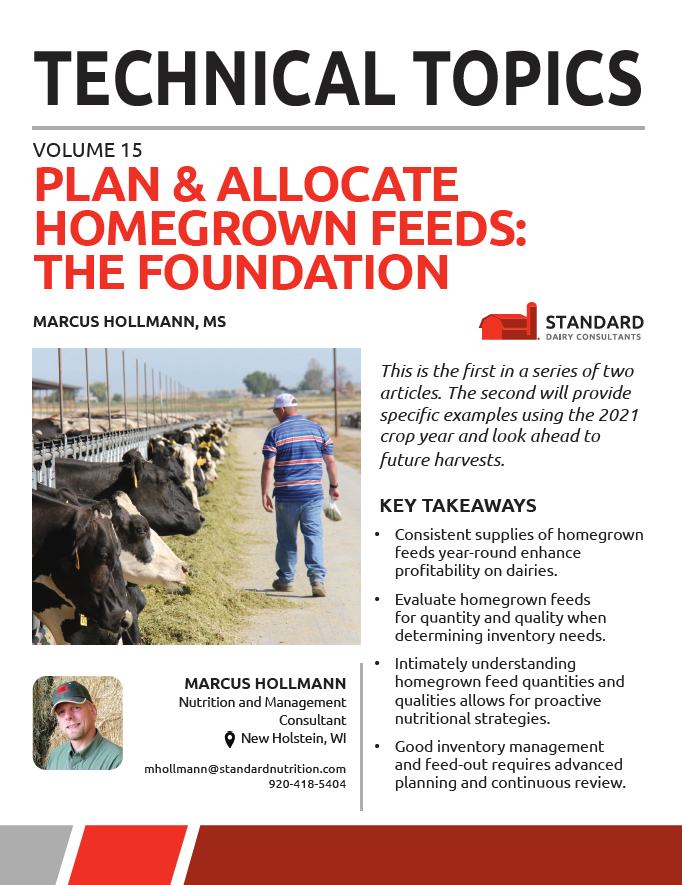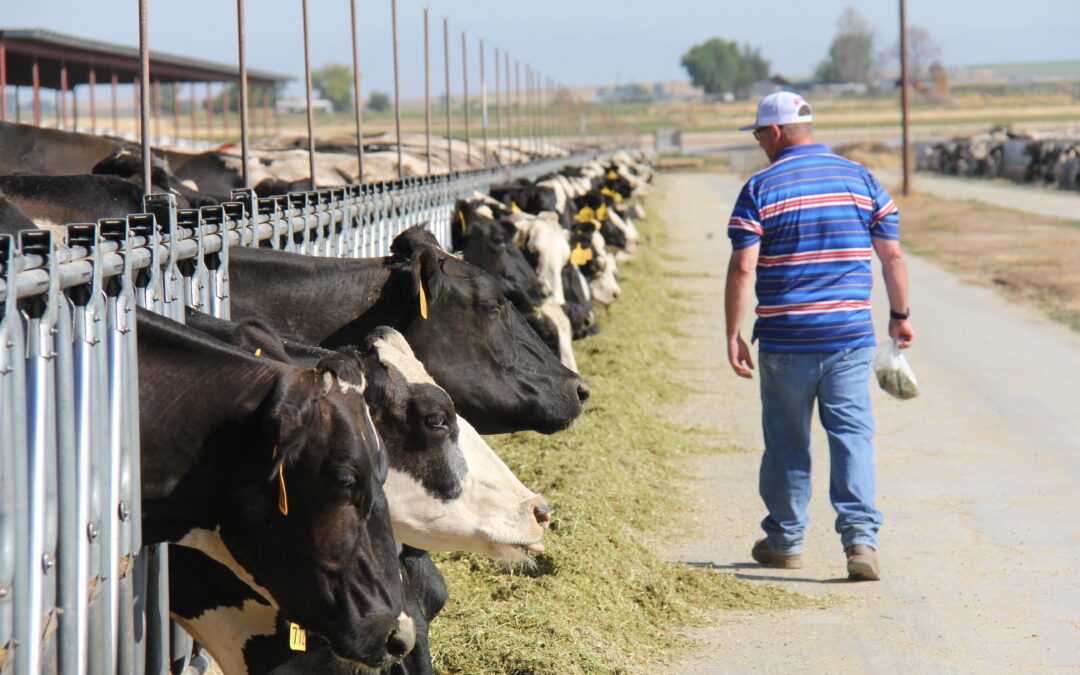Written by: Marcus Hollmann
This is the first in a series of two articles. The second will provide specific examples using the 2021 crop year and look ahead to future harvests.
KEY TAKEAWAYS IN THIS ISSUE OF TECHNICAL TOPICS:
- Consistent supplies of homegrown feeds year-round enhance the profitability of dairies.
- Evaluate homegrown feeds for quantity and quality when determining inventory needs.
- Intimately understanding feed quantities and qualities allows for proactive nutritional strategies.
- Good inventory management and feed-out require advanced planning and continuous review.

BACKGROUND
Homegrown feeds are a vital component to most profitable dairy farms. Long gone is the approach to solely owning the facilities, managing the dairy cattle, and purchasing all feeds. For most dairies today, owned and rented land or crop production agreements with local landowners provide the majority of forage crops; though, in some instances, even grain crops are included, with the premise it will add value through their conversion into milk and meat. Currently, the cost of production per unit of milk and milk solids is high. This is driven, in part, by the increased cost of purchased (commodity) feeds. This has led to tighter margins for producers, especially in previous months when there have been low milk prices. Homegrown feeds often account for the majority of lactating cow diets, and they are the primary component of non-lactating cattle diets. To optimize profitability, especially with tight margins, producers should utilize existing, on-farm feeds. In addition, they should also prudently plan their future homegrown feed needs as harvested feeds accumulate during the cropping year.
THE APPROACH
Big picture, you want to feed consistent diets year-round to optimize profitability, as diet consistency is one common denominator for most highly profitable dairies. Therefore, you want to strive as much as possible to use homegrown feeds already in storage and anticipated, yet-to-be harvested feeds. Maintaining this diet consistency includes planning homegrown feed needs, adjusting those needs as the crop year progresses, and mixing and matching various sources of feeds.
Initially, you want to break the feeding year into three segments (Figure 1). During the first segment, you manage the corn silage inventory from the time the first crop haylage is made through corn for silage harvest (broadly June through September). In the second segment, you manage the hay crop inventories following corn for silage harvest through the following year’s first crop harvest. Once you have a good understanding of the quantities and qualities of hay crops on hand, crude diets for various feed groups and estimated corn silage needs can be formulated to fill (1) the forage portion of the lactating cow diets and (2) energy needs of the non-lactating cattle. Subsequently, you can then calculate corn silage needs for the next 12-plus months. Following corn for silage harvest, the corn grain needs (i.e., any combinations of snaplage, high moisture corn, or dry corn) can be estimated. Lastly, you can estimate the amounts of protein feeds and non-forage fiber byproducts needed. Ideally, you want to protect prices for these commodities during the lowest price period, which often occurs during the fall harvest.
To take full advantage of this approach, it is critical to know the qualities AND quantities of homegrown feeds stored during the cropping year to best estimate feed needs for the year. Initially, you need to know the general nutrient profile of incoming feeds during harvest with the intention to broadly classify and rank on-farm forages. Mixing and matching high-quality homegrown feeds with lesser-quality ones, while stretching each source over a longer period, results in improved diet consistencies. Consistent homegrown feeds also allow you to play offense (i.e., make minor diet adjustments and really hone in on diet formulation in concert with cow performance).
In contrast, frequent changes in feeding rates or qualities of homegrown feeds force you to play defense (i.e., simply reacting to the changes without a true chance to relate various feeds to the production responses of the herd). The unrealized milk income and extra expenses for purchased feeds are even more painful with tight margins. Nonetheless, innovative technologies measuring rumination or eating times in individual cows provide the ability to monitor and quickly react to unfavorable changes following diet adjustments. See Predict Herd Risks When Needed Most: The Transition Period! – YouTube Nebel and Hollmann, World Dairy Expo 2021.
INSPECT WHAT YOU EXPECT
Winston Churchill, the former Prime Minister of Great Britain once said, “Plans are of little importance, but planning is essential.” Monitor and adjust, monitor and adjust, or wash, rinse and repeat. On the basis of Mr. Churchill’s quote, the key to a successful nutrition program on any dairy long-term is NOT merely producing a good plan or diet. Instead, the key is to frequently monitor, adjust and continuously plan and to be diligent about repeating the cycle. To accomplish this, you must focus on monitoring feed qualities, feed inventories and disappearances, and responses in performance to diet adjustments, most of which will be changes in homegrown feed quality or feed rates. Given this, you should measure homegrown feed inventories and their disappearances at least monthly, and more often when they are in tight supply. As a part of this, you need to calculate each rate of disappearance on-site, as this allows for the discussion of any changes in expected runout dates and potential changes in feed allocations without delay.
Here are three places where thorough monitoring is recommended:
Monitor feed quality during the corn for silage harvest
It is critical to not only have a plan for harvest in place but more so to continuously review and adjust the plan. For example, does the corn’s quality broadly match the quality used to calculate CS needs? Should you segregate lower starch, less digestible, or compromised chop for non-lactating cattle? Will actually measured qualities of freshly chopped corn change the anticipated feed rates and ultimately the tonnage needed? All too often, quick decisions made on little data (or no data at all) during harvest can come back to cost the dairy for many weeks and months in the future. Thus, you want to avoid a situation where a great idea in the heat of the moment – usually to keep the harvest moving along seamlessly – negatively impacts future profitability.
Monitor your inventories
Measuring the rate of disappearance of a feed source is inherently much more accurate than any tonnage estimates, either during harvest or from the size of a feed pile. Actual disappearance of an inventoried feed does not lie. Monitoring the disappearance of inventoried feed is also surprisingly simple, yet it does not always get consistently done. For example, if there were 100 feet of hay silage left 30 days ago and there are now 70 feet left, the disappearance rate is exactly one foot per day, so there should be 70 days of this feed left. Further, should you decide to cut the overall feed rate of this hay silage by 50%, there would be 140 days left. The rate of disappearance needs to be monitored closely in late fall when homegrown feed inventories and qualities are mostly known for at least the next seven months. So, a small adjustment in the hay silage feed rate in December is more subtle than a radical change in April. For example, a 2-pound adjustment in hay silage feed rate in December to make inventories last through mid-June becomes a 7-pound adjustment if you wait to address hay silage inventory in mid-April. The subtle change inherently results in greater diet consistency than a radical one, and thus a lower risk of profitability loss
Monitor cattle performance
Remember, you should strive to optimize performances with the forages on hand. Circling back to Mr. Churchill’s point, you monitor cattle performances in relation to feed usages and inventories continuously.
As such, you should frequently review and modify feed rates of individual feeds based partially on the following questions:
- How does the production of milk solids compare with expectations?
- How have cattle responded to changes in diets? Have changes led us down the right path, or do we need to review the changes?
- Do actual intakes match formulated intakes? If intakes are greater than expected, then the combination of forages in diets ‘feed better’ (i.e., have better digestibility) than expected, or as indicated from nutrient profiles or ration balancing model. If intakes are less than expected, the opposite is true.
- Are forage inventories available to feed more forage and less purchased feeds?
- If not, can we include non-forage fiber commodities to dilute out more expensive commodities?
- Can we improve overall forage quality in the diets through mixing and matching of sources?
Ultimately, your overall goal is to optimize profitability. Only through consistent planning and review of homegrown feed needs, in concert with feed qualities and cattle responses, can optimization of the bottom line occurs. This is why utilizing on-farm, homegrown feeds are your key to controlling purchased feed costs, while also improving your overall margins.


